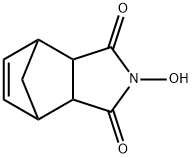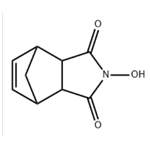N-Hydroxy-5-norbornene-2,3-dicarboximide (NHD) is a compound that has
antiviral activity and is used to treat HIV infections. It inhibits the
reverse transcriptase enzyme in the virus, which blocks the synthesis of
viral DNA. The ferroelectric properties of NHD were first observed by
observing changes in its melting point when mixed with water. This
property makes it useful for diagnosis purposes. In animal studies, a
dose of 5 mg/kg was found to be effective against cancer cells and the
drug showed no toxicity in humans at doses up to 500 mg/day. The optimal
reaction conditions for NHD are pH 6 and temperature 45 degrees
Celsius.
white to off-white crystalline powder
It decreases racemization in peptide synthesis and inhibits formation of N-acylureas.
Inhibits racemization in peptide synthesis using DCC as condensing agent.
N-Hydroxy-5-norbornene-2,3-dicarboximide(HONB) is used in solution-phase peptide synthesis. Used in the synthesis of enkephalin analogs.
Dissolve the imide in CHCl3, filter, evaporate and recrystallise from EtOAc. IR (nujol): �max 1695, 1710 and 1770 (C=O), and 3100 (OH) cm-1. The O-acetyl derivative has m 113-114o (from EtOH) with IR bands at �max 1730, 1770 and 1815 cm-1 only, and the O-benzoyl derivative has m 143-144o (from propan-2-ol or *C6H6). [Bauer & Miarka J Org Chem 24 1293 1959, Fujino et al. Chem Pharm Bull Jpn 22 1857 1974]. [Beilstein 21/10 V 188.]



